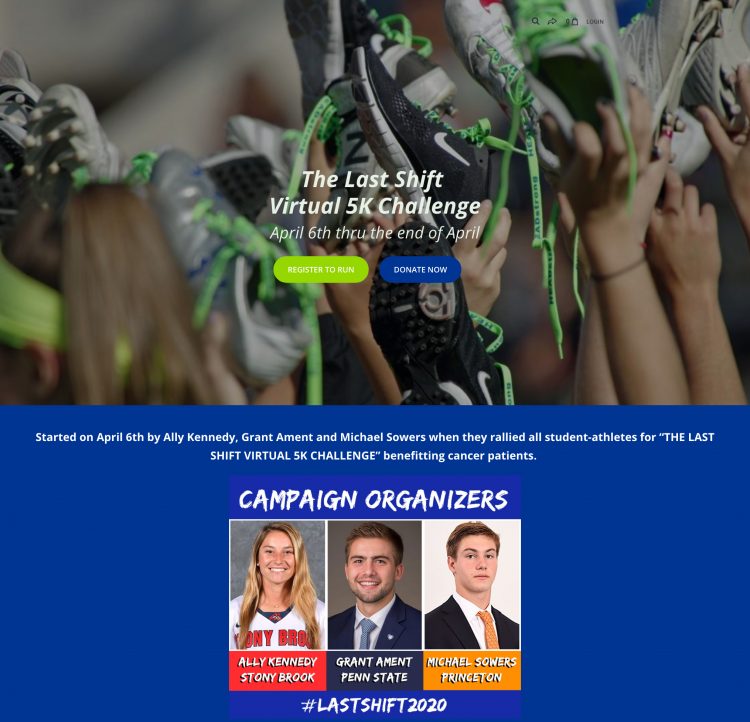5 Insider Lessons to Nail Your Next Virtual Event

An effective virtual event planning strategy builds meaningful connections with attendees without live event interactions. Events offer natural opportunities for nonprofits to engage with supporters more personally and serve as an incredible fundraising strategy to build long-term donor relationships.
Get ready to learn more about nonprofit event production, project management, and planning best practices from an organization still experiencing the positive impact of its virtual event success.
Attend Our Latest Collaborative Event
Learning From Years of Virtual Event Planning
From the initial growing pains of pivoting to virtual events during the COVID-19 pandemic to the way organizations now flawlessly integrate virtual elements into nearly all event experiences, it’s clear that the sector sees value in an online format.
We saw over 92% of virtual fundraising event attendees say they’re likely to donate in addition to any registration or participation costs. With that in mind, virtual events are a great way to host impactful sessions and experiences with supporters, like networking events or a virtual conference, while increasing donors’ likelihood of returning to give again.
Break out of on-site limitations, introduce gamification, play around with live streaming, and bring various types of events to life in a re-imagined format.
How will your organization go beyond a Zoom event to create a memorable virtual experience? We turned to the team at the HEADstrong Foundation for insider lessons to share today.
How a Virtual Format Raised Over $120,000
We reached out to Jeff Baxter, Director of Community Engagement at the HEADstrong Foundation, to find out how his team of event planners pivoted to an entirely virtual 5K, “The Last Shift,” and raised over $120,000 to benefit lives affected by cancer.
Below, we’ll walk you through how the team came up with the idea and activated a massive audience. Plus, get a sneak peek at the internal operations and the online event logistics.
Lesson 1: Know Your Audience, Intimately
When the HEADstrong Foundation team decided to mobilize its community by hosting a fully virtual 5K, they chose an event strategy based on the preferences of their unique audience: athletes and sports enthusiasts. They chose April 6, which also happened to be National Student-Athlete Day.

This underscores the importance of knowing your audience and personalizing your offerings. Whether running a 5K, hosting a gala, or orchestrating another event, you have to play to their preferences, lifestyles, and unique perspective.
Lesson 2: Fully Activate Your Audience
Knowing your audience is one thing, but getting them to participate in your event is another. For the HEADstrong Foundation, the secret to successful activation was targeting a hyper-defined audience segment with thoughtful event promotions.
The founder of the HEADstrong Foundation was a college lacrosse player, so the team decided to reach out to college lacrosse players before promoting the event to anyone else. They also agreed to use influencer marketing, targeting the nation’s top-three senior college lacrosse players (pictured above).
Leaning on Instagram to Reach a Target Audience
As part of the event marketing strategy, each player received a direct message from the HEADstrong Foundation Instagram account asking if they wanted to run in the virtual 5K and help spread the message to other athletes. From there, event organizers began targeting other lacrosse players across the country to take part in the team-building event experience.
People are accessible through social media like they’ve never been before. We went on every college lacrosse team page to find the team captains and reached out and invited them to join as well. Some participated, some didn’t, but we were still able to create a major swell of support for the event.
Start small before branching out to larger segments of your audience, much like you would with a soft launch for a fundraising campaign. Within that segment, you may even consider reaching out to specific influencers who can act as spokespeople for your event.
Additionally, your nonprofit will want to identify which platforms your target segments will most likely see your message and craft your outreach accordingly.
Make It Easy to Register
Another pre-event tactic that helped the HEADstrong Foundation was simplifying the registration process for influencers. The team made it a flat $20 to register and only asked for influencers’ names, emails, and Instagram handles.
As a result of their influencer outreach, teams began signing up left and right. Ultimately, 2,000 people registered for “The Last Shift.”
At Classy, we designed our virtual event platform for nonprofits to make registration as simple as possible. That’s true whether an event is entirely online or a hybrid event with a virtual component.
Lesson 3: Maintain Clear and Consistent Communication
As they moved through the event planning process, the HEADstrong Foundation team used various tools to stay aligned and ensure nothing slipped through the cracks. Every week, they held a virtual meeting over Google Hangouts to review updates and assignments from the previous week before tasking out new roles. Having a simple and quick way to organize conferencing with your event coordinators is key as you get closer to launch.
At the same time, they tracked all progress and responsibilities in a spreadsheet. This was helpful for items like the email marketing calendar and nailing down deliverables for each send. In one email, they included a pre-recorded video message from the president of the HEADstrong Foundation:

Then, another email that went out one week before the event featured a set of training tips, fundraising challenges, and ways for virtual participants to get others involved:

Finally, an email went out the day before “The Last Shift” kicked off, detailing what to do during the run and what to do once the run finished:

Learn how to craft expert virtual event emails with these helpful fundraising email templates.
Adding a Personal Touch to Your Virtual Event
When planning your virtual event, messaging is critical. People must understand all the details about how they can participate. They also need to feel like the message is personalized and comes from a human.
Send a few well-crafted emails to your registrants with any crucial information or asks. Nonprofit videos are also a great tool to humanize your organization and pump everyone up for the event.
Lesson 4: Get Crafty and Creative
Don’t be afraid to create something new and simple. It will open you up to a whole new list of opportunities for your nonprofit.
This was a mantra that Jeff and the rest of the team lived by during “The Last Shift.” Every idea received consideration simply because it was new, which gave rise to some powerhouse results.
Bringing Modern Donation Methods Into the Mix
First, the team encouraged all runners to invite their friends to donate to their personal fundraising page or through a “virtual high five.” With this virtual high five, people would use Venmo to send $5 directly to the HEADstrong Venmo account with the runner’s name in the transaction’s comments.
The HEADstrong Foundation team took all these Venmo transactions and entered them as offline donations into Classy. At the end of the event, they had collected an additional $4,000 from this tactic alone. Today, Classy customers can include Venmo as a payment option directly on their donation websites to make it even simpler for donors to make an impact.
Incentivizing Participants Online
Next, the HEADstrong Foundation team had to brainstorm virtual incentives for participants. They decided to offer everyone a discount code for the HEADstrong Foundation online merchandise store through a personal letter from the executive director. That way, people could buy something they wanted, and all purchases contributed to a higher overall revenue and improved metrics for the event.
Last, event stakeholders worked hard to activate their supporters’ networks by spreading the word of the 5K through personal outreach. For example, one of the event influencers reached out to his former head coach, who decided to get his entire high school team involved in “The Last Shift.”
Nonprofit social media is yet another extremely powerful tool for organizations to reach wider audiences without sacrificing their budget. For the HEADstrong Foundation team, social media was the cornerstone engagement piece across all efforts. They asked participants to tag their posts with a custom hashtag, whether promoting registration or submitting a picture of their GPS route after running.
This was crucial to creating a sense of community, which is a fundamental pillar to successful virtual events. All attendees participate separately, but your nonprofit’s needs bring everyone together.
With virtual events, if you’re not doing anything on social media, it won’t work. It has to be a socially driven thing. It drives the community feeling
Lesson 5: Start Year-Round DIY Fundraising
Once the event is over, DIY fundraising can be the perfect way to follow up with your community and nurture all your new supporters to become lifelong members.
Moving forward, the HEADstrong Foundation team will build an endurance athlete fundraising program for people to run a 5K, triathlon, or Ironman or participate in another major athletic event and use it for fundraising on behalf of the organization.
For example, if someone loves golf, they can pledge their next game. If they go for a run every day, those runs can help fundraise on behalf of the HEADstrong Foundation.
Turn their entry point to your organization through a virtual event into a way they can easily continue to fundraise for you on their terms and bring those experiences face-to-face with their communities.
Bring Your Virtual Event to Life on Classy
With some creativity and the right tools, you can grow your fundraising event revenue to reach new heights. Use the HEADstrong Foundation as inspiration for ways your nonprofit can adapt quickly, activate your audience, and drive support for any virtual event you imagine.
If you’re interested to hear how Classy’s virtual event technology can help you take your strategy from pre-event planning to post-event engagement with real-time interaction and intuitive apps, explore Classy Live today.

Attend Our Next Event for More Best Practices



